GUANTANAMO by Frank Smith, Trans. By Vanessa Place
 GUANTANAMO
GUANTANAMO
by Frank Smith
Translated by Vanessa Place
Les Figues Press, July 2014
160 pages / $17 Buy from Les Figues or SPD
As a law student, I feel that the most important demographic that this book should reach is law students—but for various reasons, it will never reach them.
When reading Guantanamo, I thought back to my Constitutional Law class and our discussions of the constitutional rights of foreign nationals. We learned about the debate through the lens of Guantanamo, specifically Combatant Status Review Tribunals (CSRT), which was challenged on constitutional grounds. As the introduction of this book informs, prisoners in the U.S. are guaranteed habeus corpus relief from unlawful detention. Such relief is generally called for when there is no knowledge of charges by or evidence against the detained person.
The introduction by Mark Sanders talks about translation and how Frank Smith drafted this book in French based on actual interrogation reports. It implies that there is no text under the text, only layers of translation with no correct source document: not only is there the language barrier between the author and the interrogation, but there is also the communication barriers between the Middle Eastern citizens and the U.S. interrogators. Law is very much the same way in having no definitive text. It is a mosaic bible made and revised by humans, primarily rich white American men (even still!) in this country. And yet, those who endeavor to work in it have their very human blind spots, such as the war vet in class who did not want to reconcile with “terrorists” having rights—that the Supreme Court should not pander to terrorists in giving them due process in our courts of law.
The text itself revolves around a trinity of ambiguity, vegetables, and the United States of America. The ambiguity in the writing comes from the use of the French pronoun on to show the absurdity and inhumanity of Guantanamo’s process. You observer a recurring narrative that the reader is unsure of is two continuous characters or two general bodies: (1) “the terrorists”; and (2) “the administrative body conducting de facto trials.” Vanessa Place translates on in a variety of permissible ways depending on tone, or not, or maybe creating her own tone in an unsettling way. Sometimes we are pronounless.
Asks if has family ties with known terrorists in Pakistan.
Answers exactly what kind of ties?
Rephrases the question, asks if any relatives have ties to terrorists in Pakistan.
Answers has no family in Pakistan. How could this be?
States has “kin” who is a member of a terrorist group responsible for attacks in Uzbekistan.
Answers no one in the family has any connection with any terrorist group in Uzbekistan to speak of. (p. 3)
And so on. Not only does this stylistic choice call to attention the human machinery at work here, but it also creates a haunting, disorienting effect. Who are you supposed to believe? There is no human face that you are supposed to recognize here. There are combating facts which simply do not add up. And here, unlike the real U.S. criminal justice system (for all its flaws), there is no plea bargain to a lesser crime, there are no charges. Your reward for confessing to being an enemy combatant is to remain there, indefinitely, perhaps forever, even if really you were just growing vegetables, at the wrong place and at the wrong time.
The whole book goes like this, in deadpan call-and-response, with occasional breaks into a very sparse poetry, absent of any embellishment. It is not quite as dry as the interrogation proceeding, but only not quite.
“The man, his wife, and his mother still believed
they were being taken to Uzbekistan
but when they reached the other side of the river
a Tajik man informed them that they were actually
entering Afghanistan
and that they would have to fend for themselves,
that Tajikistan had effectively decided
to get rid of its Uzbek immigrants
Some families attempted to object
because they did not want to be abandoned there
but they were threatened with death
if they did not stop complaining.
The man believes they were then
in the area of Ahmed Shah Massoud.” (p. 53-4)
The author instead uses this break to tell the straightforward narrative of the de facto defendant(s), in broken up third-person prose, as if these defendants were not allowed to tell their stories directly and that the only voice which spoke for them was the voice of Allah. Their voices are suppressed, and simultaneously horrifying and bland. They are made bland. They are ruled by the farming of vegetables, caring for their families through agrarian life, until they are expulsed then tricked by ill-meaning “friends.” These narratives are frequent and often in this book, and probably in life too. Yet they are rendered “boring” and unaesthetic. I think this is important.
And at the end, nothing happens. Not in this book, or in the thing it is modeled after as conceptual art, until the shifting mind-mass of law went in the direction of abolishing the kangaroo courts, and setting some of the particulars free. The undangerous ones. Hopefully—but how are we supposed to know?
The worst kind of ambiguity, yet depicted flawlessly.
***
Rory Fleming is a rising third year law student at the University of North Carolina-Chapel Hill. He is also a writer of prose and poetry.
June 30th, 2014 / 10:00 am
The Tales by Jessica Bozek
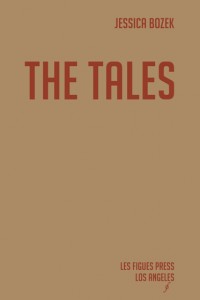 The Tales
The Tales
by Jessica Bozek
Les Figues, December 2013
76 pages / $15 Buy from Les Figues Press or SPD
Jessica Bozek calls her spurts of narrative in The Tales poems, but they aren’t, quite. Except for the sprawling middle section, Bozek’s short book is made up of justified blocks of prose such as this:
THE SAVING:
A FAIRY TALE
The loon’s lesson.
Now under funerary green, the citizens are cut off from the surrounding lands. A loon teaches them that they can dive down into their own small lake and come up in another lake. The cost of this transport is that all communication must happen underground.
The spurts trace the trajectory of someone called “The Lone Survivor” after a cataclysmic war known by its aggressors as Operation Sleep. The Lone Survivor makes his way into the world of the attacking nation, seeing visions of thriving life as he tries to hold onto his own past. From what I can see, he is eventually banished to a sort of reservation/museum-type installation, where reparations are attempted as time progresses. The political implications here are explicit, and welcome. But the value of the tales is mostly, I think, in their language, the way Bozek tells this story. Not through poems exactly. Nor, though, through fiction.
Of course, Bozek can call her work whatever she wants to call it. Poetry. Prose. Visual art. (The book is, indeed, beautiful, printed with all the white space that such short blocks of writing require, black endpaper, a red and gold Russian starkness on the front and back covers with a typeface of the same ilk.) But The Tales reminds me more of the hybrid work I am used to seeing from Tarpaulin Sky, in books like Kim Gek Lin Short’s China Cowboy and Sarah Goldstein’s Fables. In fact, The Tales earned its publication by winning the 2012 NOS (Not Otherwise Specified) Contest with Les Figues Press.
Bozek’s work here strikes me as one in a string of very compelling books of very short prose that are both language- and narrative- oriented. Such writing, I think, performs its work in a different space than poetry or prose. Where poetry, I would argue, creates much its value in the relationship between words, and more traditional fiction creates value in the relationship between paragraphs and events, Bozek’s hybrid vignettes seems to do their work between sentences, redefining causation, its images evoked with some clarity and yet set beside other images that would not “normally” come after them. The effect is a sort of circling-around, an attempt to penetrate the ineffable that is almost Zen-like. The shorts’ slow spiral tends toward some wordless meaning, I envision, drawing a picture in the readerly mind of a world with qualities so magical as to be literally inexplicable.
Part of this world is what we understand as dystopian, in the tradition suggested by the preface on “Operation Sleep,” by the book design, by words like “reparations” and “the State Museum for the Justification of Military Action.” But there’s something in the prose that is beyond words, too. In this vein—that, perhaps, of poetry—it is important to recognize that priority is given not to the narrative overall but to the effect of individual pieces. Symmetry is not a priority in this volume, and I am glad for it. Each piece stands for itself.
Which may be one reason why Bozek uses the word “poems” to describe what she’s written here. Another reason, I might guess, is her sheer personal investment in each piece, the compression of so much thought and feeling into so little language. The text of the book is followed by a full complement of back matter, sometimes outwording the vignettes themselves, as with one of the many with the title “The Lone Survivor’s Tale”:
I shed clothes in remembrance. The braided cables on my sweater unravel from the neck as I wind through the tree trunks, making a cyan tangle. When there is little left, I bite down to keep the cuffs.
Jessica Bozek explains, in her notes:
As glad as I was to have these iterations, I was even happier without them, for it is exactly the gaps in The Tales’ information that make it so compelling. The book’s middle third, the only section written in what would seem visually to be more explicitly “poetic,” ensues when the Lone Survivor “unspool[s] the words of those lost.” Across a series of mostly blank pages are scattered fragments of images and speech, remnants of some mostly erased world. The blank, here, is visual. In the rest of The Tales, it is conceptual, a blank in mental imagery, evoked in the way of the koan. So that we simply believe Bozek when she says:
I have begun weaving nests from the fallen hair on the floorboards and furniture. I leave these nests on high things outside. I want to be useful to the birds.
There is something more here, some ache, some weird impulse of energy and sadness toward a relevance that will never be relevant, not even to the few birds that remain to the Lone Survivor as companions. Not to mention the sheer image of a nest of fallen hair, wispy and whisked away in seconds by the wind.
But then, again: it doesn’t sound as good when you try to explain it. Which was why I was so happy to let Bozek’s Tales just breathe.
***
Dennis James Sweeney‘s recent work has appeared or is forthcoming in Fractured West, Sundog Lit, Whole Beast Rag, and Word For/Word. Find him at dennisjamessweeney.com.
December 16th, 2013 / 12:00 pm
Our Lady of the Flowers, Echoic by Chris Tysh
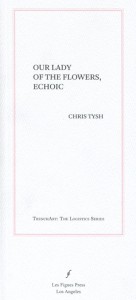 Our Lady of the Flowers, Echoic
Our Lady of the Flowers, Echoic
by Chris Tysh
Les Figues Press, Oct 2013
144 pages / $15 Buy from Les Figues Press or SPD
As the second installment of her three part project titled Hotel des Archives, Chris Tysh took up the bold task of versifying Jean Genet’s hallucinatory first novel, Our Lady of the Flowers. The original novel, as Jean-Paul Sartre implies in his introduction, is already on the brink of being poetry itself: “Are we so far from poetry? Can it be that poetry is only the reverse side of masturbation?” Tysh, whether knowingly or not, explores this very question through the creation of this work.
The structure of the poetic translation restricts itself to two seven lined stanzas per page, a form with traces of the sonnet. And like Wordsworth said in “Nuns Fret Not at Their Convent’s Narrow Room,” those who “felt the weight of too much liberty/Should find brief solace there,” in the confines of the sonnet. It was, after all, in the ultimate form of confinement—prison—where Genet, left all to himself, found the inspiratory pressure to extricate the original work out of his mind and onto brown prison paper. However, the original, in all its poetic imagination did not have the compressed punch that regulated poetry is able to deliver, at least not throughout the entire work. Rather, the original novel reads as if trudging through the muck of Genet’s subconscious desires in order to find anything worth building metaphysical meaning out of. What Our Lady of the Flowers, Echoic succeeds in doing is adding further restraint onto the original text in order to pull out the skeletal story of the original novel, which is the story, metaphorically—through a constant changing and killing off of self—of becoming an artist.
The characters in Genet’s original version are nearly empty figures (with the exception of Divine) who allow the reader to input his or her own projected experience of others into them. As one of the earliest attempts of modern queer debauchery, its form is ephemeral, hazy, experienced in the realm of spirits more so than in convention. In Echoic we get more of a straightforward narrative of events, aiding a reader of the original through this poet’s perspective on the novel. The original is, after all, highly open to interpretation, and like the scene where Genet lies in his prison cell and imagines “the hundred Jean Genets glimpsed in a hundred passers-by,” this poetic translation acts, as suggested in the title, as an echo or reflection of the original work. So naturally, some aspects may be left out, altered, and perhaps even heightened.
One particular triumph of Echoic is the calming pace verse imposes on the novel. The same haunting imagery is present, but now in a format that allows for easier focus and digestion of potently translated scenarios. This sharpening of the original sometimes makes for more accessibility, but, of course, leaves out some of Genet’s personal quirks as narrator. Let’s compare the standard Bernard Frechtman translation to Chris Tysh’s new one.
This paragraph gets condensed and altered into about four lines in Tysh’s version:
Nor the Holy Virgin, not like their wrath,
Contempt for her brand of loving
Until Gabriel makes the scene. I see him
Walking down a street, almost running
Bumping into D as the doorbell rings twice
Above the little candy store he’s ducked into
October 21st, 2013 / 11:05 am
Cunt Norton by Dodie Bellamy
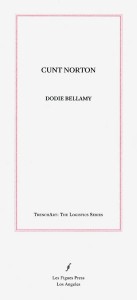 Cunt Norton
Cunt Norton
by Dodie Bellamy
Les Figues Press, November 2013
75 pages / $15 Buy from Les Figues Press or SPD
In Cunt Norton, Bellamy slices the canonical texts, lifts the raw skin, and slides all kinds of exciting things into the wound. Then she sews it back up. The result is a bulging, infested boil of sex and gender. The result is dirty love poems secreting out the orifices of our favorite fathers. (And one mother: Dickinson.)
Playing off of William S. Burroughs’ “cut-up” technique, Bellamy published Cunt Ups in 2001. Now she’s back at it, “cu(n)ting” up the 1975 Norton Anthology of Poetry. She selected thirty-three poets from the anthology and has re-imagined their texts: cutting and interspersing their words with hypersexual language. Poets ranging from Shakespeare to Ashberry still sound remarkably like themselves. They are recognizable—only sloppy with desire. Dripping wet.
The multi-gendered speakers in Cunt Norton end up sounding at turns psychotic, absurd, and boring—which comes pretty close to the actuality of sexual encounters and the language we use for desire. When the speaker in “Cunt Auden” says, “You be a good girl—I’ll take care of you—lay here in my hands with their many fingers. I’ve never ever given anybody help who didn’t come” (57), I want to barf at the sad, true, cliché of it. I feel the same with “Cunt Yeats,” which begins: “Gloom is in my mind, and I have to fuck you so bad. Good girl. Good girl” (40). “Cunt Blake” finishes with a hearty, “I poke out and in thee in so many places, the Air shreds to Rags and the Heavens tear” (21) and “Cunt Tennyson” promises to “fuck thy portal until mouths, foreheads, eyelids lose all boundaries” (35), both of which are equally hilarious and scary. I am reminded of all my worst sexual experiences.
Other pieces are full of rollicking, gender-bending, free-for-alls. Take, for example, “Cunt Frost:” “My clit stands still and dances—it looks huge, the outer lips filling the abyss’ void with emptiness. It cries out for you. […] My cock is normal size, ready to throw back without regret into your cunt or your large intestine” (43). The Great Men from the Norton Anthology are marionettes in Bellamy’s hands. Their reputations are at her disposal: their genitalia grow and morph, their gigantic desires never satisfied.
But Bellamy’s book is as much a political act as it is a book of poetry.
Let me offer an example why. Recently, after I participated in a reading, a fellow (male) poet asked me why I write about the same thing (sex) all the time. And why do I use such vulgar (cock, cunt, etc.) language? He suggested that I would get more publications if I varied my subject matter and cleaned up my language a bit.
Dodie Bellamy’s Cunt Norton exists as an answer to these kinds of questions. What I mean is: Dodie Bellamy is a woman who writes about sex. Who writes with verve and risk and imagination. Who isn’t afraid of language, or of dead white men, or the reverence we are supposed to have for them. Dodie Bellamy will not be silenced or ashamed. When Ariana Reines writes in the book’s introduction that this “could be the most joyful book on Earth” and it “made me feel so good I laughed so hard I cried,” what she may be articulating is how powerful it feels to witness a woman writing exactly how she wants to write, refusing to be silenced (by the canon, the patriarchy, any other poet’s aesthetic or ethical impulse).
October 14th, 2013 / 11:05 am
Among the Dead: Ah! and Afterward Yes!
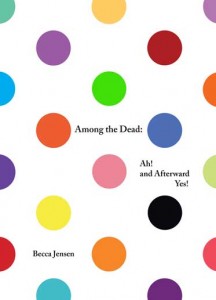 Among the Dead: Ah! and Afterward Yes!
Among the Dead: Ah! and Afterward Yes!
by Becca Jensen
Les Figues Press, March 2013
75 pages / $15 Buy from Les Figues Press or SPD
Winner of the inaugural Les Figues Press NOS Book Prize as selected by guest judge Sarah Shun-lien Bynum
In Sarah Shun-lien Bynum’s forward for Among the Dead: Ah! and Afterward Yes!, she identifies the “atmosphere of allusion” that Jensen creates in the collection: “the feeling of reading great books: of being inside an enormous bell, a bell cast from the world’s wide store of epics and elegies and tales and novels, unable to tell where one’s own voice ends and the reverberations begin.” The ambition of such a project is belied by the small, and thus manageable and relatable, lens of an absurdist nuclear family: an unnamed daughter, a Collector, and the parents Mr. and Mrs. G. The family speaks and acts through fragments of English literary canon; they fish, sail, swim, and drown in the heartbreaking lines of Tennyson, Eliot (both T.S. and George), Keats, and others, but the ties of family make Jensen’s work more than collage poems. Because the characters are real within the world of Jensen’s collection, they have mysterious histories, present foibles, and future prospects.
The sophistication in Jensen’s assembly of Among the Dead: Ah! and Afterward Yes! can be seen as an advocacy for the acknowledgement of poetry as a product of linguistic innovation that cannot shed its ancestors. But what is important about the way Jensen looks back on everything that has created her work? The family in Among the Dead, though abstracted through a lack of traditional narrative, does not take place solely in a nostalgic chamber of fragments. There is a lived experience, an authenticity that can be vouched for despite its “fiction-ness.”
Mr. Grumble Grumbles
Like many heroes who find themselves haphazardly at the center of the plot,
Mr. G concluded that
a) this was a very stupid story
&
b) he didn’t care to hear it again.
“Mr. Grumble Grumbles” is a poem that appears very early in Jensen’s book, a piece that is un-prefaced by any of the Collector’s fragments until much later. Instead, readers are presented with an exhibit from George Eliot’s The Mill on the Floss.
July 8th, 2013 / 11:00 am
By Kelman Out Of Pessoa
 By Kelman Out Of Pessoa
By Kelman Out Of Pessoa
by Doug Nufer
Les Figues Press, 2011
194 pages / $15 Buy from Les Figues or SPD
Why write a conceptual novel? Is conceptual writing meant to be read? Is conceptual writing truly “conceptual” in the way conceptual art was? If conceptual art was more to be read than it was to be seen, then, following the same “logic,” is conceptual writing more of a spectacle than it is a reflection? Isn’t writing by and large dematerialized anyway? Doesn’t reading atomize as much as it coheres? Isn’t the novel ultimately only intelligible in terms of a material transcendence? Is Douglas Nufer’s By Kelman Out Of Pessoa more Sol Lewitt or more Rene Girard?
I think the latter rather than the former. I think the conflation of Oulipian constraint and conceptual aesthetics has become too easy. I think schematicism need not make a virtue of the perfunctory. I think that novels like Nufer’s, or Harry Mathews’ Cigarettes, can simultaneously be novels and “anti-novels”: mere pretexts or engines for putting one word, then one sentence, then one paragraph, then one chapter, after another, but also “subjective experiences” that offer readers traditional pleasures and vertigos. I think that the author’s and the reader’s processes have to collaborate in order to complete the novel, and this book; they are symbiotic, even if one antedates / predates (upon?) the other. I think all novels—and, by extension, all characters, all points-of-view, all settings, all symbols, all themes—are thus accidents of time, eruptions of advantage and disadvantage. I think about Michel’s capture in Bresson’s Pickpocket, how it is a direct result of his notion of who he is in relationship to someone else who, in a context explicitly over-determined by competitiveness, is not quite whole or anything beyond a phantom. I think that readers always have a hand out for the last word.
Louis Bury, in his introduction, writes: “Doug Nufer wrote By Kelman Out Of Pessoa by going to the track once a week for an entire horseracing season, placing bets on behalf of three fictional characters’, the results of which, in turn, dictated the structure and plot of the novel.” Louis Bury, in his introduction, writes: “The difference between the type of order play produces and the type of order art produces is that the former tends towards reductive simplicity, the latter towards complexity, even entropy.” Louis Bury, in his introduction, writes: “Each of the novel’s principal literary influences can be seen as the embodiment of a novelistic desire. Kelman: the desire to write about horse betting and have it be something other than genre fiction. Pessoa: the desire to make an elaborate show of masking and unmasking aspects of oneself.” Louis Bury, in his introduction, writes: “Blaise Pascal’s famous wager—that it’s a good bet to believe in God because if you win you gain everything and if you lose you lose nothing—was a bet, ultimately, not about God’s existence but about the nature of life itself: that we humans possess more purpose and meaning to our movements than mere game board tokens.”
What are we really saying when we say that a work of art, like a novel, “moves us”? What are we really saying when we say that we want to improve ourselves? What are we really saying when we say we’ve been a victim of bad luck? What are we really saying when we say that we’ve sabotaged ourselves? What are we really saying when we say that the story means what it does when it comes to its end? What are we really saying when we say, “Don’t worry; I’ve got a plan.” What are we really saying when we say we want to be more or less like so-and-so? What are we really saying when we say that there is a real world? What are we really saying when we say to writers: “Small is beautiful”? “Kill your darlings”? “Find your voice”? “Write what you know”? “Don’t lose your reader”?
January 7th, 2013 / 12:00 pm
25 POINTS APPROACHING THE MEMOIRS OF JONBENET BY KATHY ACKER BY MICHAEL DU PLESSIS
 The Memoirs of JonBenet by Kathy Acker
The Memoirs of JonBenet by Kathy Acker
by Michael du Plessis
Les Figues Press, 2012
103 pages / $15.00 buy from Les Figues Press
1. I have only read one true-crime novel or account or whatever they’re called within the genre–if you count Peter Sotos as a true crime author (why would you?) I guess this is a false statement–a book on JonBenet, and it was sort of astounding and blew my mind. I know most of these true crime books are about two steps away from conspiracy theorists & 9/11 truthers, but ultimately the way evidence is presented, if not actual evidence, creates a new world of fiction that is both troubling and astounding.
2. And as such I’ve had a JonBenet obsession ever since. There’s a gross collaboration going on within the recounting of the JonBenet narrative: the young white princess of middle america challenged by a vicious S/M monster snuff ring kiddie porn mystery. And perhaps the perpetrator was her parents? It’s like the pool party at the Hard Rock Casino in Vegas; this is the true avant-garde of American letters, the fuckTness of the popular zeitgeist.
3. Then there’s Kathy Acker, who I want to haunt me like the sun does, and she does sometimes, and she surrounds the air of the people I eat dinner with here in San Francisco.
4. Kathy Acker is a force invented by both fiction and second-hand statements that act as a guide when the bullshit becomes too much.
5. Have I mentioned there is also a chapter where JonBenet as Kathy Acker (or the other way around) is O from Story of O (which retains such a more beautiful sounding title en francais, Histoire D’O) and Rene is nowhere to be found and certainly NOT Little Lord Fauntelroy but rather Boulder is Roissy somehow and the carpet is all similar and the entire facade crumbles under the watchful eyes of O I mean JonBenet I mean Kathy Acker I mean Michael Du Plessis.
6. Right now, while writing this, I am hungry and want to go make myself a sandwich but I’m trying to stave off the hunger until this is finished because JonBenet is a doll and a doll is not real and dolls do not have to eat to sustain themselves and TO BE REAL IS THE WORST.
7. Nothing in this novel moves in a linear fashion. Events happen and then other events happen but there is certainly not any discernible narrative arc unless you literally construct one out of “your ass” which, I suppose, is possible, but ultimately not within the diegesis of the novel itself.
8. Of course what I mean by the above point is that within this realm of circumstantial ‘realism’ that may or may not be what the point of contention on this blog even is lately, it’s ultimately futile when you realize that modernity is over (jesus christ get over it) and we are all so post-grand-narrative that the way things move is LIKE THIS, okay? Yesterday I went to work I ate a pretzel I took like three shits I sat on some stairs I read a Franck André Jammes book I took the BART to my boyfriend’s house and then I passed out without having sex because I was feeling exhausted HI THIS IS HOW NARRATIVE WORKS IN REAL LIFE, WHAT THE HELL IS THIS REALISM SHIT.
9. It’s like the way narrative works in this book is how Kathy Acker understood narrative which means, both, that Du Plessis understands Acker and that both Acker and Du Plessis understand narrative.
10. What I mean by this is the movement in this book is gorgeous but stilted which makes it even more beautiful. Why are we reading? READ MORE >
October 18th, 2012 / 2:40 pm
2500 Random Things About Me Too
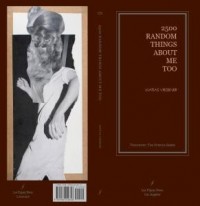 2500 Random Things About Me Too
2500 Random Things About Me Too
by Matias Viegener
Les Figues Press, 2012
246 pages / $15.00 buy from Les Figues Press
Rating: 9.0
For us it is so normal to see the clouds from above, and inside.
— section xxxix, line 12
By extrapolating the popular Facebook meme, 25 Random things about me, duration generates gravity in Matias Viegener’s 2500 Random Things About Me Too (Les Figues Press, 2012), blowing aloft a cloud of identity–a portrait of the artist’s wandering consciousness. Viegner’s sequence of anecdotal strands, aphorisms, autobiographical trills, and questions both large and small are keenly paced; fragments hang alone indefinitely while others pick back up a few lines down or pages away, forming themes that resonate in opp- and apposition throughout the work. This deceptively loose push-and-pull provides much of the work’s excitement as associations spark, link with others and hover or hang solitary and pleasantly naked.
Here’s an example from the text, titular and relatively contained:
October 10th, 2012 / 1:09 pm
Q.E.D. – Part 3: An evening of Authentic Objects
The MAK Center Schindler House, Los Angeles
13 June 2012
Context Note: In April, May, and June of this year, Les Figues Press hosted a short series of long conversations on queer art and literature. Titled Q.E.D., in honor of Gertrude Stein’s novel by the same name (and one of the earliest coming-out stories), each Q.E.D. event explored the constructions of speech, art, literature, materiality, and sex. The conversations were moderated by Vanessa Place at the historic MAK-Schindler House, L.A.’s original nod to green architecture.
Q.E.D. Part Three featured Dodie Bellamy, Julie Bamber, and Terry Castle.
***

An evening of Authentic Objects: Julie Bamber, Dodie Bellamy and Terry Castle in conversation.
In the third installment of Les Figues Press’ Q.E.D. Series, moderated by Vanessa Place, the initial questions were, “Does an object need a form? Does an objection? Does anything speak for itself?” Artist Julie Bamber, writer Dodie Bellamy and critic (and writer and artist) Terry Castle assembled in the MAK Schindler House in West Hollywood to discuss questions of object-hood before an excited audience.
Patrons gathered, drank Pellegrino and looked at programs. Grapes and cookies sat on a table on the lawn. The copper of the fireplace was bright, next to the concrete walls of the house, with low beams suspended with small lights. A sliding door opened the wall. Afternoon light slanted across the concrete floor, grey.
July 6th, 2012 / 12:00 pm
Q.E.D. – Part 2: WHAT MATTERS/WHAT’S MATTER
The MAK Center Schindler House, Los Angeles
9 May 2012
Context Note: In April, May, and June of this year, Les Figues Press hosted a short series of long conversations on queer art and literature. Titled Q.E.D., in honor of Gertrude Stein’s novel by the same name (and one of the earliest coming-out stories), each Q.E.D. event explored the constructions of speech, art, literature, materiality, and sex. The conversations were moderated by Vanessa Place at the historic MAK-Schindler House, L.A.’s original nod to green architecture.
Q.E.D. Part Two featured Brian Teare, Michael du Plessis, and Lincoln Tobier.
***
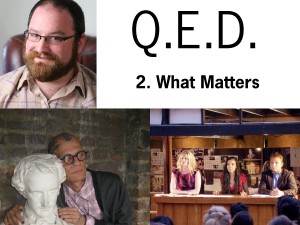
Blocked off by thick and towering bamboo shoots, the hush of the Schindler House is a surprise even given its location on a quiet, residential West Hollywood street. The House belongs to the MAK Center for Art and Architecture in Los Angeles; it was originally built in 1922 as a two-family home and workspace by Rudolph M. Schindler for himself, his wife, and another couple. The House’s then-innovative indoor/outdoor, open-plan design was the basis for the “California houses” that came to litter the landscape throughout the mid-twentieth century. It is hard to imagine anyone actually living in the House as it stands now: almost entirely empty, the structure and its surroundings feel more like a church or a yoga studio. Visitors speak quietly, and it is hard not to step lightly, as if any exuberant move might knock down the concrete walls and let the rest of the world into this sacred bohemia of careful art and right living.
July 4th, 2012 / 12:00 pm
